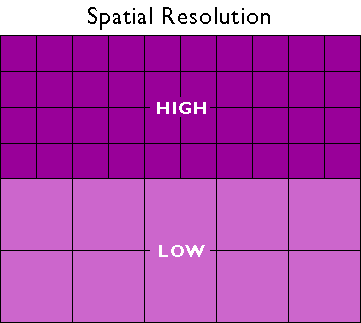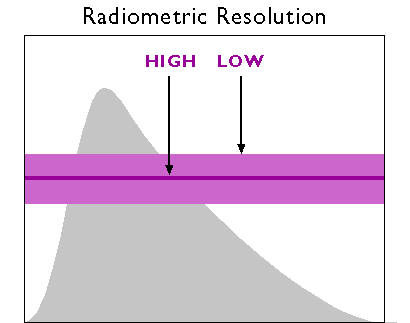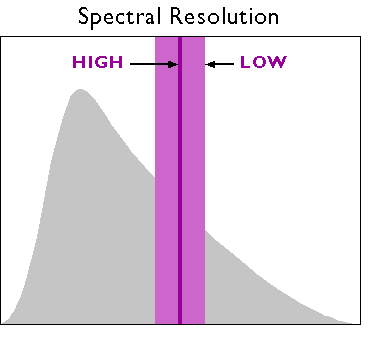So far, you've read that remote sensing systems measure electromagnetic radiation, and that they record measurements in the form of raster image data. The resolution of remotely sensed image data varies in several ways. As you recall, resolution is the least detectable difference in a measurement. In this context, four of the most important kinds are spatial, radiometric, spectral, and temporal resolution.
Spatial resolution refers to the coarseness or fineness of a raster grid. It is sometimes expressed as ground sample distance (GSD), the nominal dimension of a single side of a square pixel measured in ground units. High-resolution data, such as those produced by digital aerial imaging or by the Quickbird satellite, have GSDs of one meter or less. Moderate-resolution data, such as those produced by Landsat sensors, have GSDs of about 15-100 meters. Sensors with low spatial resolution like AVHRR and MODIS sensors produce images with GSDs measured in hundreds of meters.

The higher the spatial resolution of a digital image, the more detail it contains. Detail is valuable for some applications, but it is also costly. Consider, for example, that an 8-bit image of the entire Earth whose spatial resolution is one meter could fill 78,400 CD-ROM disks, a stack over 250 feet high (assuming that the data were not compressed). Although data compression techniques reduce storage requirements greatly, the storage and processing costs associated with high-resolution satellite data often make medium and low-resolution data preferable for analyses of extensive areas.
A second aspect of resolution is radiometric resolution, the measure of a sensor's ability to discriminate small differences in the magnitude of radiation within the ground area that corresponds to a single raster cell. The greater the bit depth (number of data bits per pixel) of the images that a sensor records, the higher its radiometric resolution. The AVHRR sensor, for example, stores 210 bits per pixel, as opposed to the 28 bits that older Landsat sensors recorded. Thus, although its spatial resolution is very coarse (~4 km), the Advanced Very High-Resolution Radiometer takes its name from its high radiometric resolution.

A third aspect is spectral resolution, the ability of a sensor to detect small differences in wavelength. For example, panchromatic sensors record energy across the entire visible band - a relatively broad range of wavelengths. An object that reflects a lot of energy in the green portion of the visible band may be indistinguishable in a panchromatic image from an object that reflects the same amount of energy in the red portion, for instance. A sensing system with higher spectral resolution would make it easier to tell the two objects apart. “Hyperspectral” sensors can discern up to 256 narrow spectral bands over a continuous spectral range across the infrared, visible, and ultraviolet wavelengths.

Finally, there is temporal resolution, the frequency at which a given site is sensed. This may be expressed as "revisit time" or "repeat cycle." High temporal resolution is valued in applications like monitoring wildland fires and floods, and is an appealing advantage of a new generation of micro- and nano-satellite sensors, as well as unmanned aerial systems (UAS).